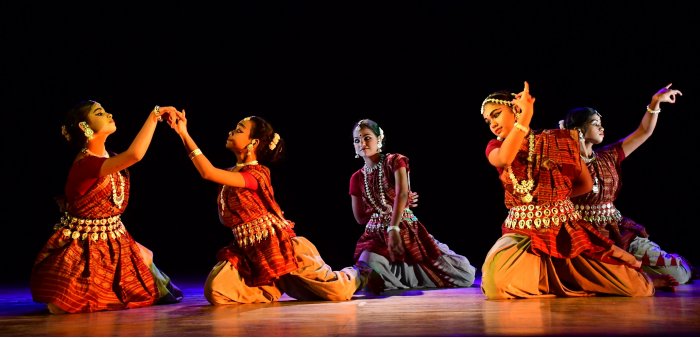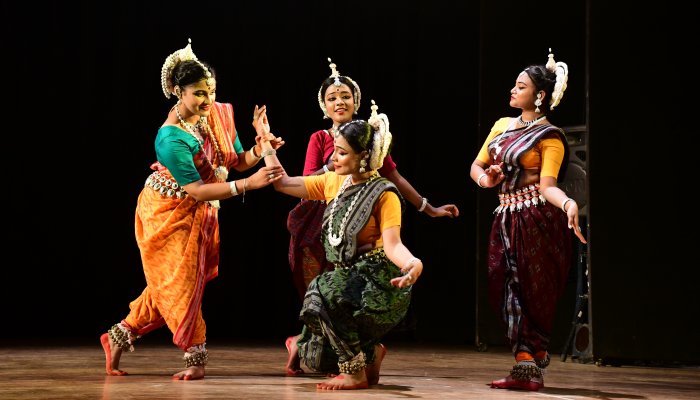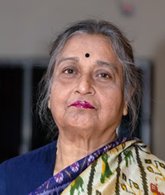
|   |

|   |
19th Sangam Festival by Art Vision - Dr. Nita Vidyarthi e-mail: nitavidyarthi@gmail.com Photos courtesy: Art Vision December 6, 2023 The annual Sangam Festival by Art Vision, Bhubaneswar, was conceived by acclaimed Odissi dancer Ileana Citaristi as an offering in new and exclusive choreographic compositions of Odissi and another Indian classical dance style (by rotation) to share experiences and creative ideas both in dance and music, on a common ground with artistes belonging to different fields on the same platform, since 2005. Well in its 19th year, this year's offering at Rabindra Mandap, Bhubaneswar, saw two thought provoking compositions by the disciples of Ileana Citaristi's Art Vision in Odissi and a slice of mythology in Mohiniattam by Gopika Varma and her team of Dasyam Centre of Mohiniattam, Chennai and Bangalore. Ileana Citaristi's productions embrace performance text not with mundane dramatic subjects or situations. They have not only panned a large spectrum from mythology, literature, to contemporary issues even to a folklore like 'Duare paka nata' (last year) down the years, but have also invited her viewers with celebration of all emotions aiming at thought provoking social issues - sometimes negative, without getting anyone hurt - evoking awareness through her art. Her work plunges audiences into conversation without dissociating her art from the artiste. Most importantly, the items, full length or shorter ones, do not lose the powerful kinetic relationship between language, movement and music.  Ileana Citariti's disciples Her opening item "Make Room for Elephants" was inspired by a short poem for children written by the celebrated Ruskin Bond with the same title. It was meant to instil love and concern for the importance of the animal world and was performed by younger students of Art Vision. A genuinely sweet poem showing kindness to a baby elephant and his family, was transformed to a fine, refreshing choreographed piece replete with delightfully executed graceful swaying hand movements depicting trunks. Intertwining and interlacing movements of one hand of the dancers with each other, while their other hand was placed at the back (depicting tails) created a fine imagery of baby elephants playing with each other. It was like watching five baby elephants happily playing in the forest! With an imaginative treatment of recognizable classical Odissi sequences, each cued exactly to the musical rhythm, once again Ileana Citaristi was successful in conveying a perfectly meaningful message through her remarkable sensibility and merit. The five dancers cannot be praised more for their training, skill and teamwork. The joyous rhythmic medium paced music and soundscape was full of low frequency rumbles and was the sole support of the dancing. It was comprised of a good measure of flutes, sound of bells (ghungroos) in sync with proper beats revealing the walk of elephant herds, and interspersed with the sound of their trumpets. Annada Prasanna Pattnaik must be lauded for crafting the appropriate music in tune with nature that dazzled for his expert musicianship.  Sharira Art Vision's powerful and heart-wrenching production 'Sharira' conceived and choreographed by Ileana followed next. Linking multi-layered portrait of the dressing of a devadasi to the haunting images of the confrontation of disrobed women through the traditional songs of Janardan Dasa and modern one by Devdas Chhotray respectively, Citaristi's tragic exploration of the female body's physical and emotional borders interpreted through captivating songs, music, poetry and dance loaded the audience with sensory experiences breaking the barriers between audience and performers. In her concept note of 'Sharira,' Citaristi says, "When I started to choreograph the song by poet Janardan Dasa on the aharya of a devadasi depicting her ornaments, attire and dress and describing how beautiful she was feeling wearing all these, the news of the two women disrobed and paraded naked in Manipur hit the headlines. This dance is my reaction and tribute to them." Citaristi presented seven female dancers entering with a rich and neat execution of nritta embellished with fine glimpses of Pallavi and the refrain of 'tananaterena' followed by dancing with ukuta of Satchidananda Das. The choreographic nectar of the performance accompanying the song "Juda bandhili Jharakathi nei" (I did my hair bun with jharakathi) from Danai Dasa Malika in Sangita Panda's strong shrill rustic voice flowed through an elaboration of the Odissi vocabulary of already familiar steps, as the devadasis dress up while singing. Their effects quickened the vision, to unfold the beauty of a succession of pictures of dressing with ornaments, flowers, fixing tahia, finishing with a vermillion spot on the forehead, kohl in the eyes and painting alta (red liquid) on the feet. This was enhanced by the ability to grasp the theme of the composition and luxuriate in every moment and every posture of the highly trained dancers. Especially delightful was the delicate twists and turns of leg movements in the sitting position. The dancers were at their sensitive best in the disrobing sequence, very decently portrayed by two dancers with the strong violin strokes enhancing the intensity in conveying the disgraceful situation. Devdas Chhotray's composition "Those hands which decorated us moments before are disrobing us now…" concluded with the touching poignant stanza; "We are not only bodies We do have souls too White, unblemished" The soul-stirring production made with vivid honesty was a meld of raw and honest poetry, refined dance movements with rustic intimacy of traditional music that brings truth closer to the audience. With music and vocals by Sangita Panda and rhythm composition by Satchidananda Das and recitation of the poem in English at the end by Ileana Citaristi, every aspect of the presentation fell into place.  Gopika Varma and disciples The interesting Mohiniattam presentation 'Kandein Swapnam' (I saw a dream) was a dance drama by the acclaimed Guru Gopika Varma and team about dreams, the activity which makes sleep restful and waking stages hopeful. Conceived and choreographed by Gopika Varma with music composition by Kalamandalam Vishnu, the production was a garland of four different narratives of dream sequences from mythology. Opening with the dream that came to fruition and brought fulfilment of desires was the familiar story from Srimad Bhaghavat of Princess Usha, daughter of Banasura, falling in love with Sri Krishna's grandson Aniruddha in her dream. The second story was that of Shakuntala and King Dushyanta from Abhigyana Shakuntalam where Shakuntala's dream of meeting her husband was lost due to the wrath of sage Durvasa. It was a dream which beckoned but turned out to be alluring and did not materialize. The third was the beautiful story of Andal, the only female Alwar among the 12 Hindu poet saints of south India. It was a dream that resulted into a blissful union of Andal and Sri Ranganatha. Andal's dream of marrying the man she dreamt of was the result of a powerful desire in a borderless state between sleep and wakefulness. At Srirangam, Andal was said to have disappeared inside the temple of Ranganatha, whom she considered to be her husband. The fourth was a story based on folklore where you dare not dream; the nightmares interrupt sleep with fear and horror. Once again an enjoyable story of Narada wishing to have a wife. He pleads with Lord Vishnu to grant him one, Lord Vishnu obliges but only in his dreams. Narada, wishing to try his luck for three wives, approaches the Lord who grants him his wish but what ensues is nightmares. Harassed, Narada refuses to marry in reality.  Disciples of Gopika Varma The presentation captured audiences with the magic of the story of dreams and its imagery in chiselled movements of classical Mohiniattam embellished with gentle, graceful, facile, sliding movements and easy going rise and fall of the body and the characteristics sways. A virtuoso of a high calibre, Gopika Varma in the lead as Usha, Shakuntala and Andal was in top form and captured the audience with her abhinaya and left an indelible impression with her dignified execution. Her brilliance of choreography consisting of a fine selection of chuzhipus and adavus in the pure Mohiniattam sequences interspersed in the storyline showed solid training of her disciples. The sparkling costumes in golden silk added an extra edge to the very gratifying production.  Dr. Nita Vidyarthi is a veteran critic of performing arts and writes on dance, music and theatre in leading publications. |